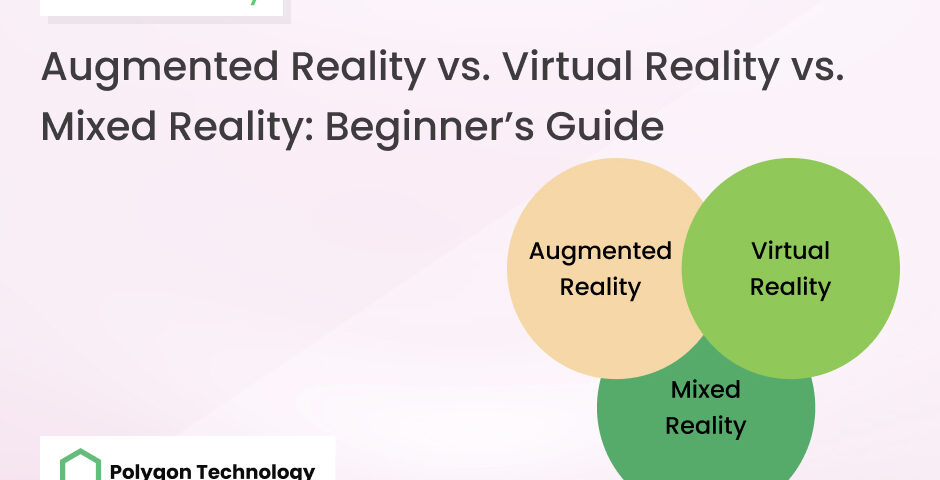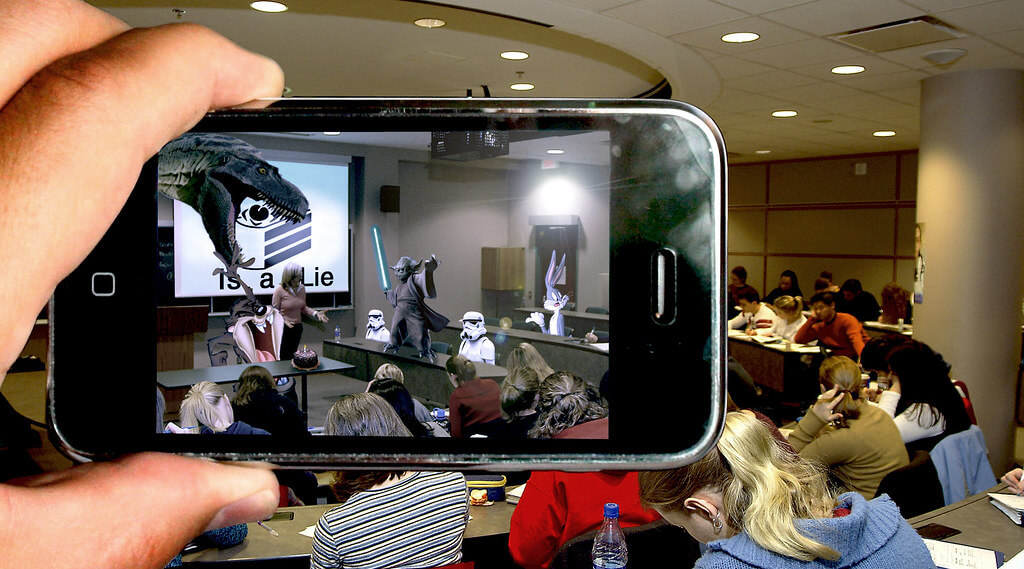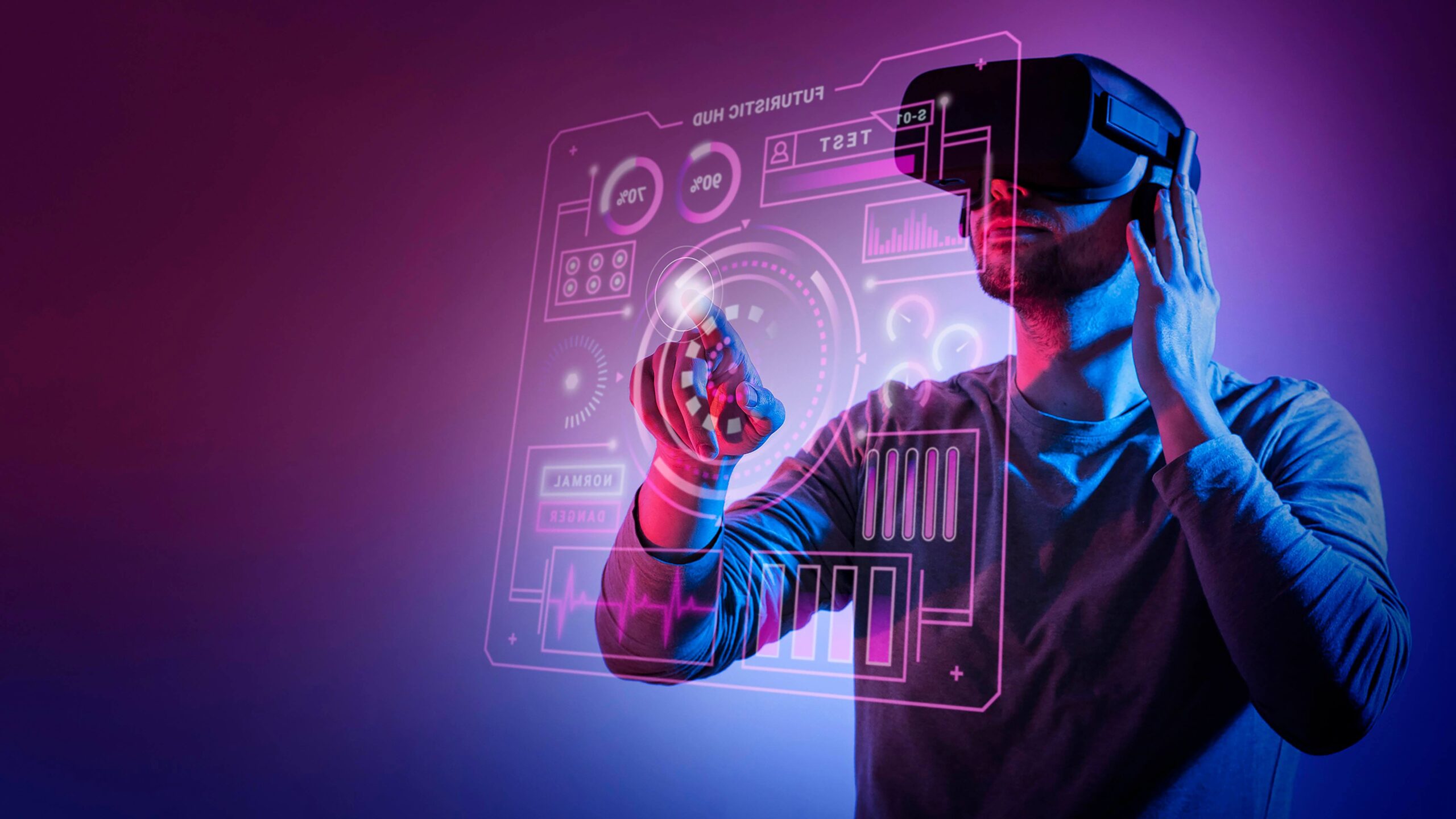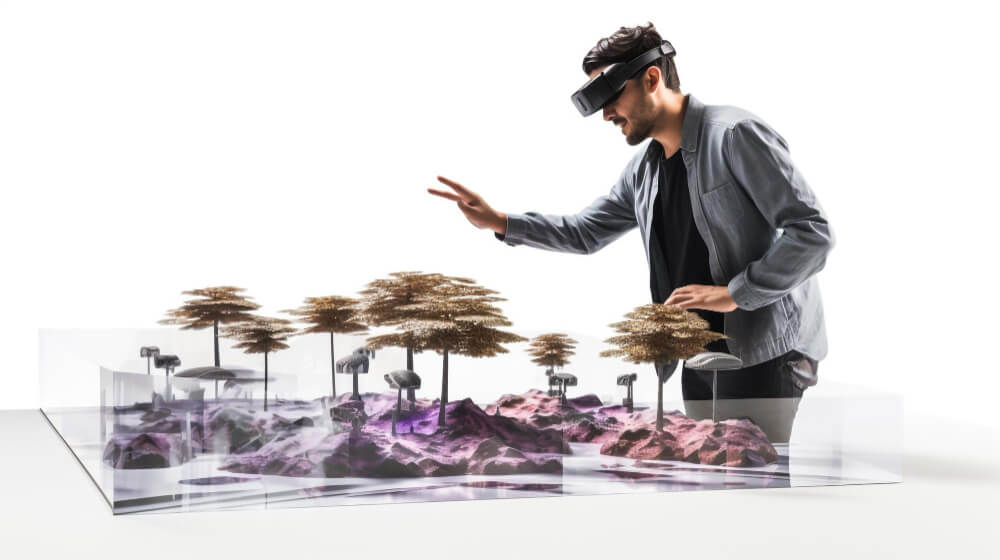
Augmented vs. Virtual vs. Mixed Reality: Beginner’s Guide
Augmented vs. Virtual vs. Mixed Reality: Beginner’s Guide

Md. Rabiul Alam Sarker
Rabiul Alam brings a blend of manual and automation expertise to the world of software testing. With a deep understanding of the entire testing life-cycle for dynamic web and mobile applications. His experience spans popular testing frameworks like Selenium, TestNG, and Appium. Additionally, he possesses hands-on knowledge of DevOps tools like Docker, ELK stack, and CI/CD pipelines.

Md. Asad Chowdhury Dipu

Mixed reality, virtual reality, and augmented reality are 3 major extended reality technologies that have caught a lot of attention. Extended reality is like a big umbrella term that covers all kinds of technology that change reality by adding digital objects to the real world.
It might seem difficult to understand the comparison of augmented reality vs. virtual reality vs. mixed reality. However, since they show up a lot in movies, most people know a bit about them already. Every one of these technologies mixes the real and digital worlds differently.
This article discusses the differences between MR, VR, and AR to help people understand how they can be used properly.
What Does Reality Mean?
Have you ever argued with somebody about a color? Maybe you thought it was dark blue, but they insisted it was black. It happens because each of us builds our own reality based on how we process info and our life experiences. This affects how we see the world. Our genes play a big part in this.
Humans often mix up what’s real with what’s physical. They find it difficult to understand why VR (Virtual Reality) feels so lifelike, even though they know it’s not real. To understand VR, AR, or MR technologies, you have to understand how we each make up our own reality. It’s based on what we sense, whether it’s from the real world or the digital world.
When we watch movies, we go through a similar experience. Remember the last time you laughed or cried? Even though you knew it was just a movie, it still got to you, right? That’s because if a movie’s good, it feels real, even when you know it’s fiction. Extended reality technologies intensify the experience, adding another level and making it feel even more real.
Wearing a VR headset puts you right into a digital world. The information your senses pick up from the digital content makes it feel real, overpowering any thoughts that it’s not. At that moment, your body believes it’s real. Moreover, for extended reality technologies to work properly, they have to feel real. The only difference is how much they use real elements versus digital elements.
Overview of Augmented Reality
Augmented Reality, or AR, mixes computer-generated images, graphics, or interactive data with what we see in the real world. It’s like adding a digital layer on top of reality. You can witness a composite view of digital and physical or real-world elements in the augmented reality experience. There is usually no interaction between the real-world and digital elements in AR experiences.
However, some augmented reality experiences might allow for some degree of interaction between virtual and physical components. To use AR, all you need is a smartphone with an AR app and a camera.
Two important things that make this technology work are the camera’s ability to capture what’s around you as you move around and the software that creates and displays computer-generated images or content.
An excellent example of this is IKEA’s new AR app. It lets you see how any space or room would look with their brand’s furniture just by using your phone. Another excellent example is Tony Stark’s Iron Man helmet. Its screen shows him vital info, like his altitude, how far other things are, and how fast someone is moving.

Another entertainment-based augmented reality example is the game Pokemon Go. You can play it on your smartphone and see digital characters in real places.
Key Features of Augmented Reality
Maintained Awareness of the Physical World: Unlike VR, AR allows users to see the physical environment alongside digital elements.
Overlaying Digital Content: AR improves the physical world by overlaying digital content onto what users see around them, often instantly.
Integration of the Physical World and Virtual World: Users can engage with both the physical world and the virtual world at the same time, which creates an integrated experience.
Applications: AR is used in education, healthcare, gaming, retail, navigation, advertising, remote assistance, and some other sectors.
Example Products: Vuzix M400 Smart Glasses, Epson Moverio BT-40S Smart Glasses, Lenovo ThinkReality A3 Glasses.
What Are The Use Cases for Augmented Reality?
Improves Warehouse Operations: AR technology has the potential to improve warehouse operations, too. With AR smart glasses, warehouse workers can easily find the quickest path to grab a product for a customer from the warehouse. These smart glasses can then alert the worker when they have reached the right spot and confirm where items are located on the shelves.
Display Useful Details: An AR headset in a manufacturing setting can show useful details like a machine’s serial number and model, along with its repair procedures and manual. It can link up with a computer or tablet so a supervisor can monitor what the worker sees and give verbal guidance on using or fixing equipment if required. Also, an augmented reality headset can show animated instructions on how to do machinery repairs or perform specific tasks.
View Menu Items in Restaurants: Restaurants could offer diners the choice to use AR technology to view menu items either when ordering through their mobile phones or in person. This technology can provide customers with extra details about the food, such as the size of a specific order, which might boost customer satisfaction. In addition, AR has the potential to save restaurants money by cutting down on the need to reprint paper menus.
Overview of Virtual Reality
This technology puts users right into a virtual world created by a computer. The most advanced virtual reality experiences even let you move around and hear sound in a digital world. Also, you can use special hand controllers that make the VR experience even better. You might remember the exciting experience of using Mattel’s View-Master back in the 1960s.
Today’s VR is like a modern, newer version of that sightseeing effect. It uses lenses in a headset’s viewport and a device where the VR experience is created or stored. Depending on the type of headset and device used, VR can do many things.
You can go from just watching to feeling fully immersed. With a remote control linked to the headset, you can interact with 3D objects in the virtual world. This works for virtual interfaces, VR app games, and apps.

Hollywood movies like Ready Player One and The Matrix show VR as a computer-made, totally immersive world, with all the physical sensations of the physical world perfectly mimicked. While we are not there yet with smell, taste, and touch, VR is still a useful technology, even if it’s only partly immersive.
Key Features of Virtual Reality
Full Simulation: In this technology, people immerse themselves in a completely artificial world that’s three-dimensional, interactive, and generated by computers.
Separation from the Physical World: VR headsets block out the physical world, letting users dive completely into the virtual environment.
Immersive Digital Environment: Virtual reality technology offers a completely interactive and immersive digital environment that separates users from the real world.
Application: Popular applications of VR include education, gaming, simulations, training, virtual tours, and therapy.
Example Products: HTC VIVE Pro 2, Lenovo Mirage S3, Meta Quest 2.
What Are The Use Cases for Virtual Reality?
Develop a Virtual Model: Manufacturers can use VR to develop a virtual model of a particular product to understand how it works inside and keep track of its lifecycle.
Train Employees: Manufacturers can also use a special VR headset to train employees, analyze equipment, and assess production procedures. For instance, employees can virtually recreate the manufacturing procedure and analyze it through a VR simulation to find better ways to operate specific machines.
Usage in the Healthcare Sector: The healthcare sector could use VR for various purposes. For instance, it could aid in exposure therapy for people dealing with PTSD and in rehabilitation for patients with neurological diseases.
Overview of Mixed Reality
Mixed reality combines AR and VR to provide the best features of both environments. For example, mixed reality works with a headset similar to VR, allowing us to see through a clear display while overlaying virtual visuals onto our surroundings.
What sets MR apart is how interactive it is and how realistically it adds virtual elements to what we see. Instead of just using phone screens or remote controllers, you can interact naturally with the digital content using gestures with your fingers and body.
A mixed-reality headset shows information that matches up with certain areas in users’ real world, letting users interact with it in a digital space. For instance, a mixed-reality headset can project a virtual mouse onto a desk so the person wearing it can click it.

In the world of mixed reality, companies like Microsoft, with their HoloLens, and Magic Leap, with their big investments, are leading the industry, although Magic Leap’s product is still in the concept stage. Apple and Google are big players in AR, but for now, mixed reality seems to be more in the hands of Microsoft and Magic Leap.
Key Features of Mixed Reality
Interactive and Attached Things: In mixed reality, virtual things can interact with and attach to physical world things, reacting to what the user does and how they move.
Seamless Mixture of Virtual and Real World: Mixed reality blends virtual content into the physical world smoothly, keeping track of where things are and letting you interact with real objects.
Spatial Mapping and Understanding: Mixed reality systems grasp the physical surroundings, allowing interaction and precise positioning of virtual objects in the physical world.
Applications: MR is used in design, gaming, training, education, remote collaboration, architecture, and other areas.
What Are The Use Cases for Mixed Reality?
Visualize A Store Layout: Retail merchandisers can utilize mixed reality to visualize a store layout before implementing it in reality. For instance, a hologram can preview how adding a promotional display at the store’s entrance will appear.
Students Can Improve Their Learning: Students can improve their learning by engaging with virtual content via 3D simulations and projections. MR aids in reinforcing educational concepts without the potential risks associated with real-world learning. For instance, a student who is learning skills for operating a museum can practice cleaning an ancient artifact using MR without risking damage to a valuable item.
See a Holographic Picture of A Machine: A technician who wears an MR headset can see a holographic picture of a machine, like an engine, and virtually disassemble it to inspect its inner workings. This method saves time and eliminates the need for physical tools that are typically required for equipment inspection.
Augmented Reality vs. Virtual Reality vs. Mixed Reality
To successfully incorporate AR, VR, or MR into your business, it’s crucial to understand augmented vs virtual vs mixed reality. While each has different uses, they’re often mixed up because their acronyms are frequently used interchangeably. Here’s a simple differentiation between AR vs VR vs mixed reality.
Augmented Reality vs. Virtual Reality
VR offers you access to a fully immersive 360-degree virtual world where you would appear as a 3D avatar. You can navigate through the virtual environment, interact with it, grab and move objects, and communicate with others you encounter along the way.
Consider the virtual meeting room as an example of virtual reality. It replicates the physical office environment, creating a sense of familiarity. This allows employees to come together for special occasions, routine updates, or remote town halls, just as they would do in the physical world.
Augmented reality (AR) adds extra things to what you see in the real world, unlike virtual reality (VR), which completely changes your surroundings. With AR, you can use your phone or tablet to put digital objects into the real world you’re in.
In an AR scenario, reality blends with digital elements. Instead of being fully immersed in a digital world, you stay connected to the real world. Virtual stuff like pictures, sounds, text, or videos get put into your physical surroundings.
For example, AR lets customers get more information about products or see how an object would look in their own home. Deloitte states that 61% of shoppers would pick stores that use AR instead of those that do not, and 71% mentioned they would shop more frequently if AR apps were available.
Augmented Reality vs. Mixed Reality
When it comes to mixed reality vs augmented reality, MR is almost similar to AR because it doesn’t take you away from your physical environment. Instead, it adds digital objects to your surroundings. But unlike augmented reality content, which you can retrieve with your phone, MR needs a special headset.
AR overlays do not really mix with the real world, but sometimes, you can interact with them using certain software. MR is different. It puts digital objects on top of the physical world, and they can co-exist and interact with each other as you move around. Even though AR and MR can do some of the same things, mixed reality might offer more ways to interact with digital objects.
This is because you don’t have to hold onto a device to experience mixed reality—it’s hands-free. However, this also means that it’s harder for most people to get their hands on. It is projected that over 5 billion people worldwide have phones, but the same can’t be said for MR glasses, which are still new and expensive.
Conclusion
Numerous technologies change how we see reality by adding digital objects to the real world in different ways. Virtual reality, augmented reality, and mixed reality are all part of this, and they each give you different experiences and applications.
You can think of all these technologies as being on a scale called the virtuality continuum. It shows how much digital objects block out the physical world and how much you can interact with it. If you can picture this virtuality continuum in your mind, you will see the differences between augmented reality vs. virtual reality vs. mixed reality more clearly.
Tags : ar, augmented reality, mixed reality, mr, technology, virtual reality, vr